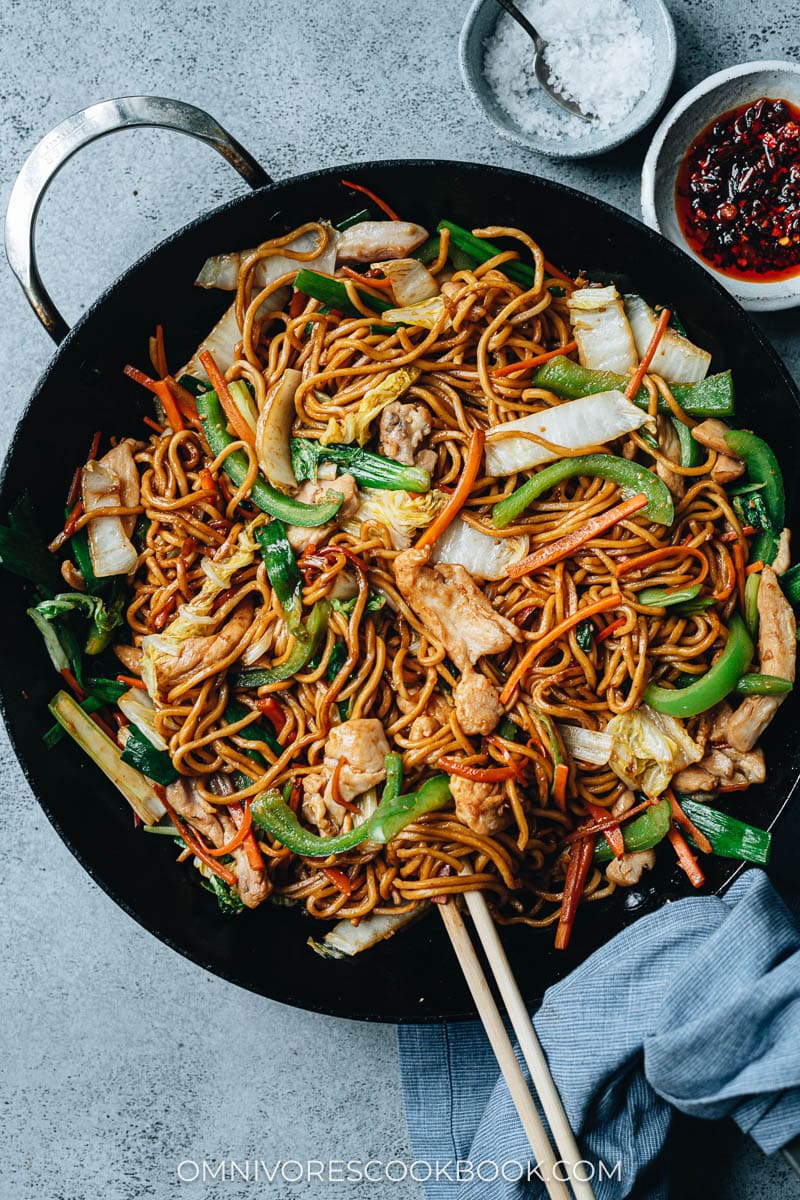
Chicken lo mein is one of those comfort foods like pizza and burgers, that you might find yourself craving on any occasion. No matter whether it’s a busy Monday night, or when you’ve just come home after a trip, or are feeling cozy and want to stay in and watch TV, you might want to reach for that small box of Chinese takeout that is loaded with flavorful noodles and tender chicken. I’m not surprised that many people associate chicken lo mein with Chinese takeout. It’s definitely one of the iconic dishes of Chinese cooking.
Here is the fun part – you can make chicken lo mein at home, one that is not only practical and easy enough for a home cook, but my recipe will also help you make it as tasty as the restaurant version.
Let’s jump into the details!
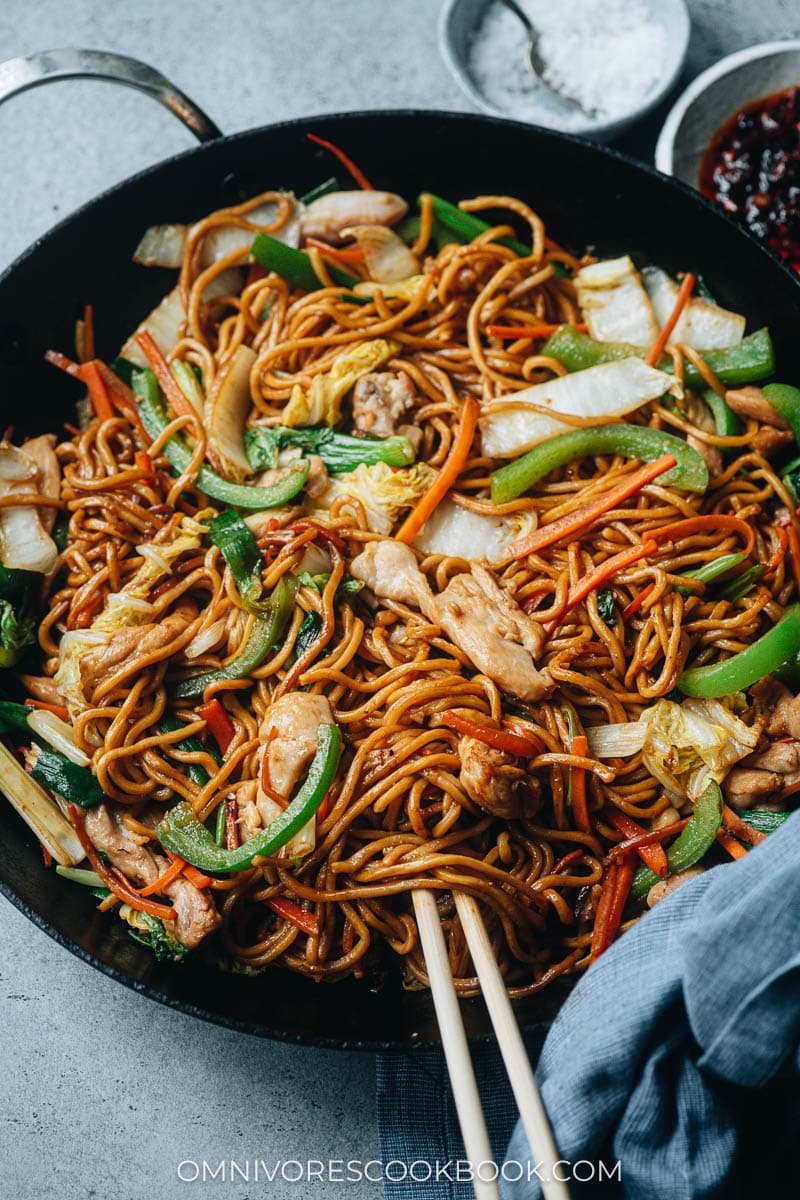
Chicken lo mein ingredients
What type of noodles to use
The biggest difference between chicken chow mein and chicken lo mein is the type of noodles used. Chicken chow mein uses thin chow mein noodles that create a crunchy crispy texture once fried in oil. Lo mein uses thick egg noodles that yield a chewy texture once cooked.
The best noodles for chicken lo mein are fresh lo mein noodles. You can find them at Chinese markets or large Asian markets such as H Mart. They are usually stored in the refrigerated or freezer section.
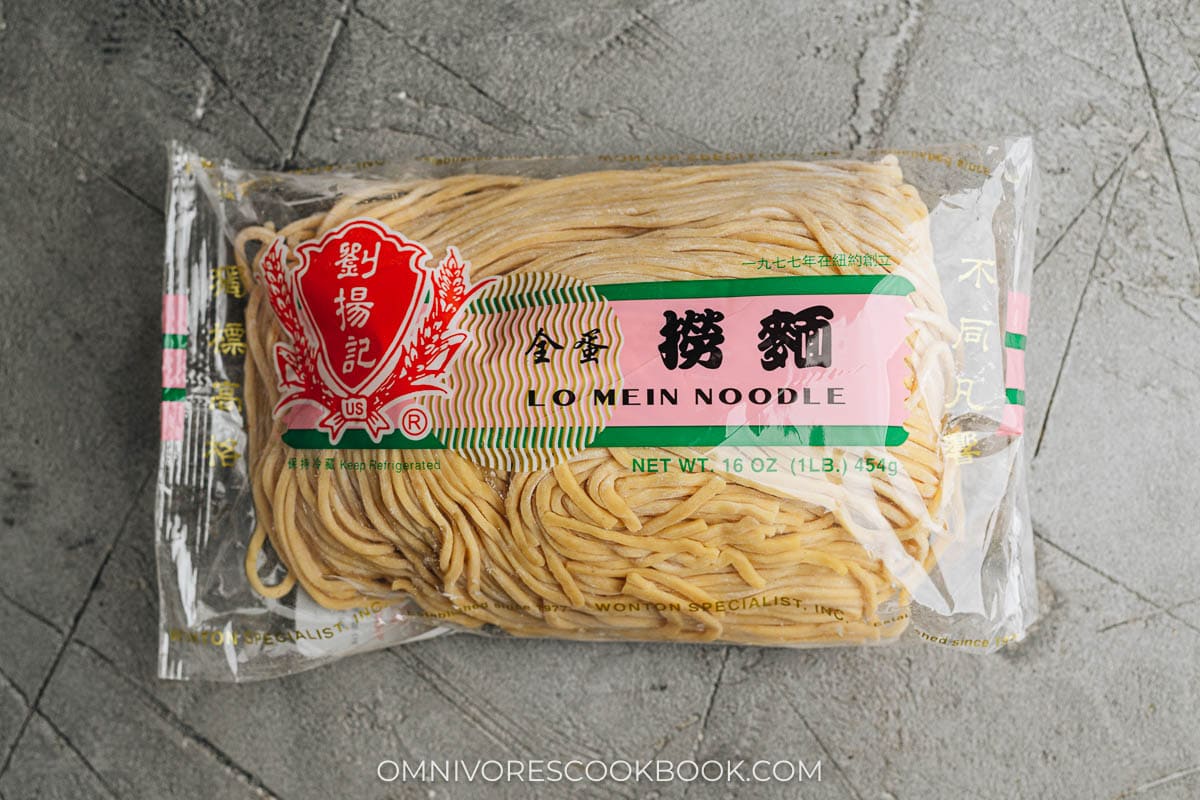
Alternatively, I’ve found that udon noodles and thicker dried wheat noodles also work in this dish. However, I highly recommend sourcing fresh lo mein noodles if you want to replicate the restaurant experience. Unlike dried noodles, fresh lo mein noodles yield the satisfying chewy texture that is the highlight of the dish.
How to create the most tender and flavorful chicken
Always always marinate your chicken before cooking. It only takes a minute to prepare and 10 minutes to marinate. But it makes a big difference. Your chicken will end up juicy and more tender and bursting with flavor. The cornstarch not only tenderizes the chicken, but it also protects it from overcooking in the hot pan. It’s an important practice in Chinese cooking that I never skip.
What vegetables to use
I love adding tons of vegetables to my chicken lo mein, as they give the dish a delightful texture and make your meal more balanced. In this recipe I used napa cabbage, carrot and pepper. You can also replace them with other vegetables you might have on hand.
The rule of thumb is to choose vegetables that have different textures and colors.
Here are some alternative vegetables to use in chicken lo mein:
- Cabbage, baby bok choy, spinach, Chinese broccoli (to replace napa cabbage)
- Bamboo shoot, water chestnuts, hot peppers (to replace green pepper)
- Onion, zucchini, mushrooms, bean sprouts (to replace carrot)
Note, the cooking time of the different veggies varies. As a rule of thumb, hard vegetables such as carrots, water chestnuts and carrots take longer to cook (3 to 4 minutes). Spinach and bean sprouts take the shortest time to cook, as little as 1 minute.
If you’re not sure about the proper order to add the veggies, cook them individually until almost done, then add them back into the pan later on. This way, your veggies will always cook perfectly and maintain their vibrant colors.
Mise en place
Once you’re ready to cook, your table should have:
- Chopped veggies: cabbage, pepper, carrot, green onion
- Mixed sauce
- Marinated chicken
- Chopped aromatics: ginger and garlic
- Cooked noodles
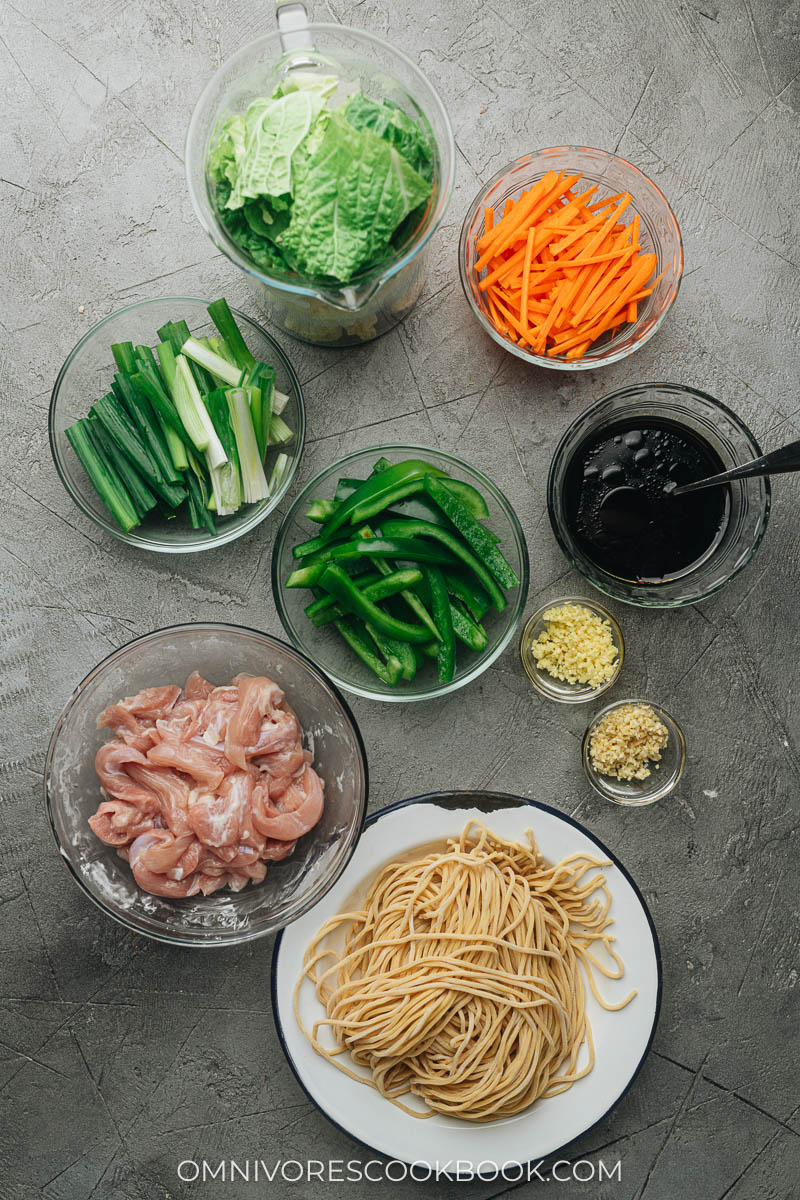
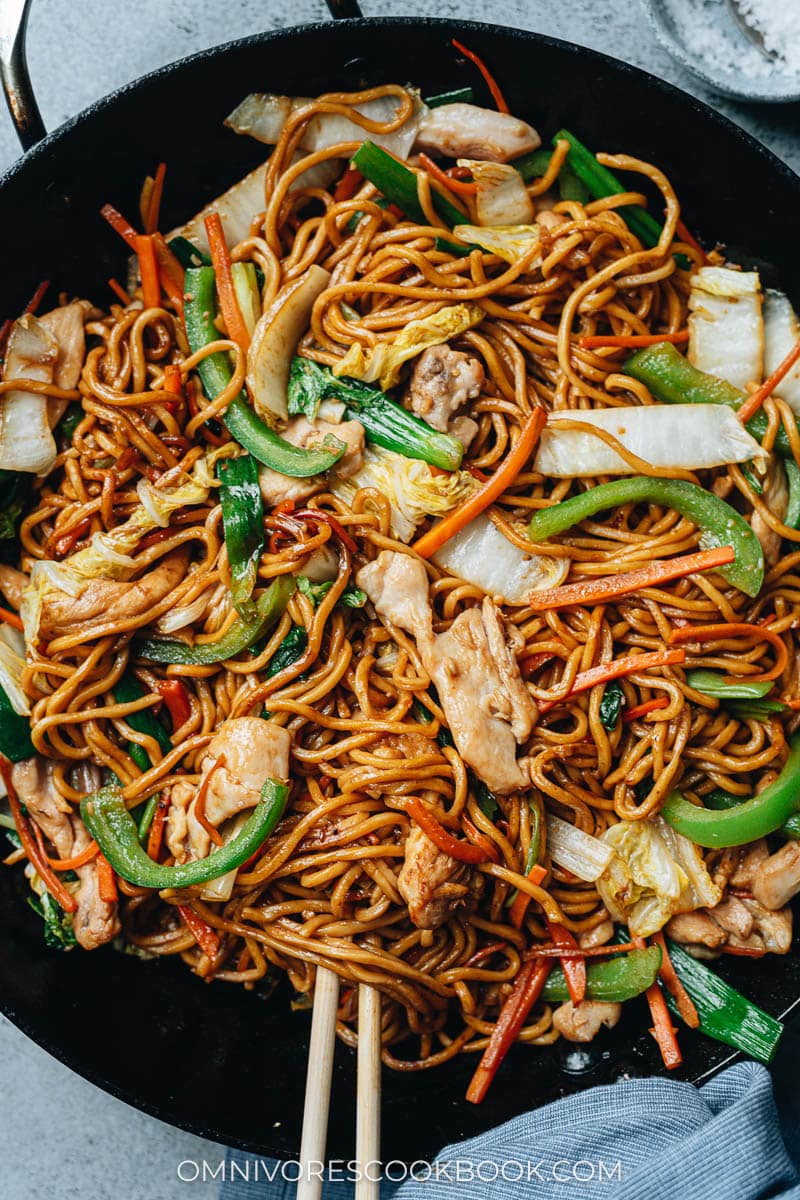
How to make restaurant-style chicken lo mein
Cooking chicken lo mein is super easy once you have prepared the ingredients.
- Pan fry the chicken until just cooked and slightly browned
- Gently saute the aromatics
- Cook the napa cabbage and carrots until al dente
- Add the noodles and sauce, toss together
- Add the green onion and pepper
- Add back the chicken, toss everything together
PS: I like to have very crunchy peppers, so I add them at the very end. If you prefer a more tender texture, you can add the pepper and green onion before adding the noodles and give it a quick 30-second stir fry.
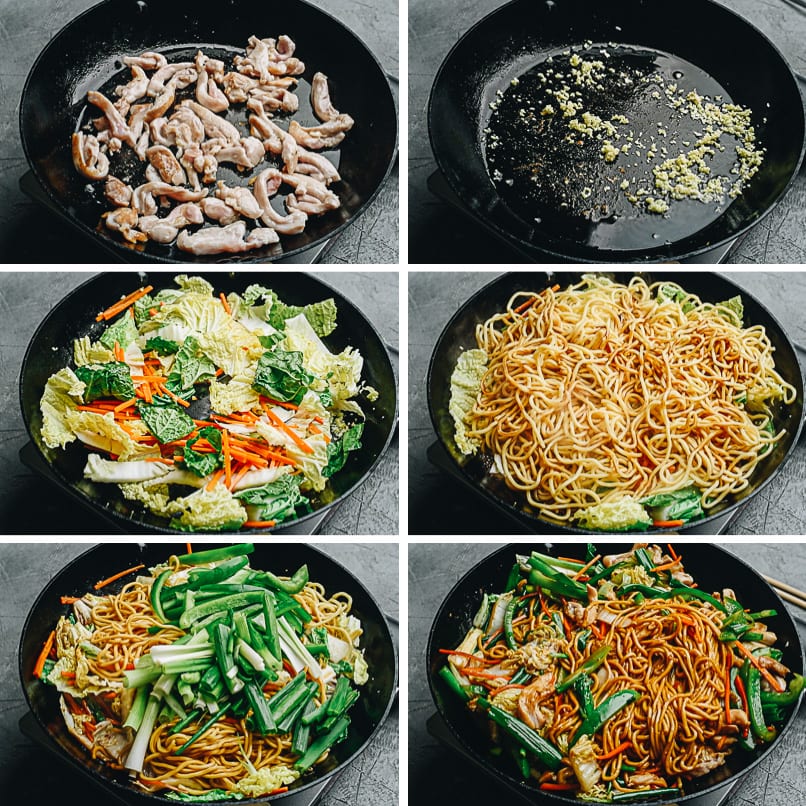
Why you don’t need a wok
I expanded on this topic in my post Wok vs. Stir Fry Pan and you can find more information there. But, long story short, you can make a delicious chicken lo mein without a wok as long as you use a lot of aromatics (fresh ginger and garlic), a great lo mein sauce, the correct type of noodles, and a pan that’s hot enough. You can achieve all of these by following my recipe below with a large nonstick skillet or a carbon steel pan. In fact, if you have an electric stove or induction stove at home, a skillet will heat up better than a wok because it has a larger contact area with your stove. I toss my noodles using a pair of tongs to prevent the ingredients from flying out of the pan.
What NOT to do
The biggest mistake when making lo mein is to crowd the pan with too many ingredients. When you do this, the pan will take a long time to heat up, so all your food will be steamed instead of seared. The dish will end up watery, soggy, and generally lacking in flavor.
The recipe below fills up a large 12.5” (32 cm) frying pan. If you want to tweak the recipe, make sure not to use too many ingredients that crow the pan.
Afterthoughts
OK, this might be a lot of information to take in. But trust me, if you simply follow my recipe and try this dish once, you’ll be impressed at the results – the flavorful chewy noodles, tender chicken, crisp veggies, and rich sauce that is bursting with flavor.
I love homemade chicken lo mein even more than the restaurant version because I like to load it up with a lot of vegetables and I can choose higher quality ingredients. I hope you like this one and happy cooking!
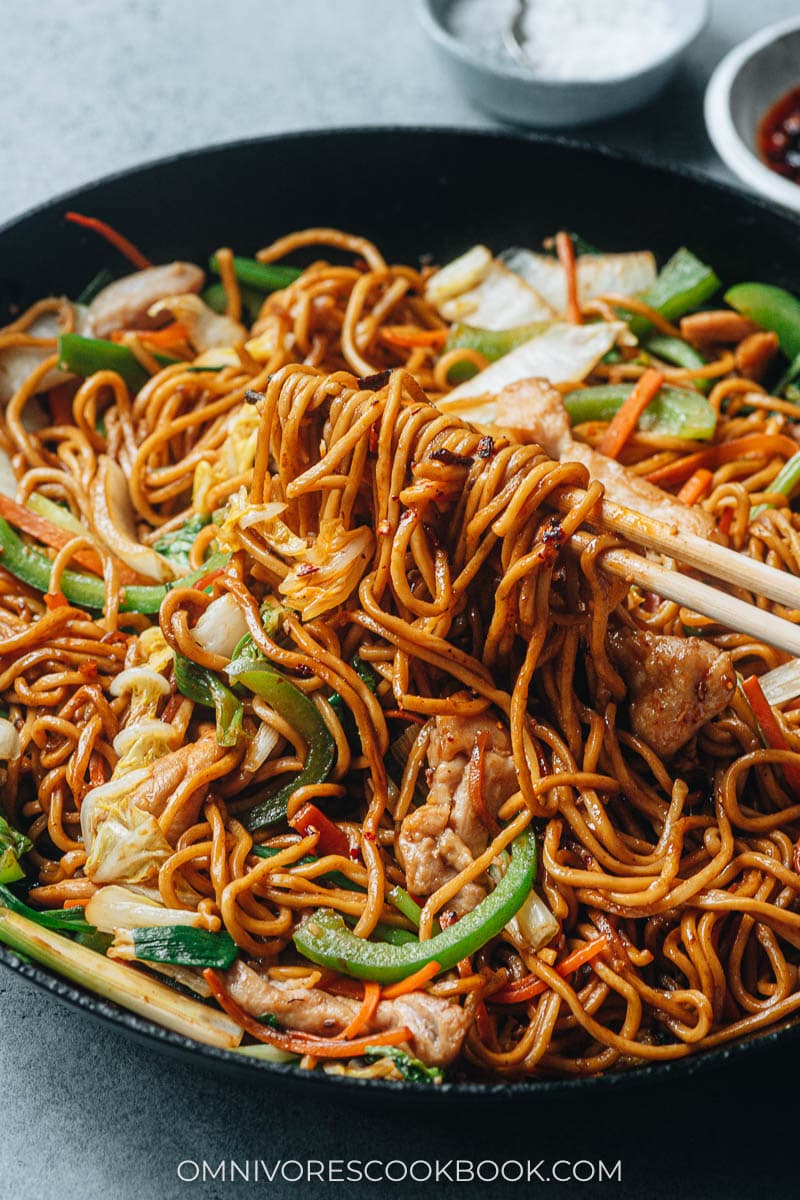
More Chinese takeout dishes
- Beef Chow Fun
- Pork Chop Suey
- Cashew Chicken (腰果鸡丁)
- Sweet and Sour Chicken
- Egg Drop Soup
- Beef and Broccoli
Chinese Cooking Made Easy
Are you new to this website? This free email series is a great place to start. I’ll walk you through a few of my most popular recipes and show you how and why they work. You’ll quickly start to cook better Chinese food in your own kitchen.
Watch video

Chicken Lo Mein (Restaurant Style Without A Wok)
Ingredients
- 10 oz fresh lo mein noodles (or 6 oz / 170 g dried lo mein noodles)
Marinade
- 8 oz boneless skinless chicken thigh , cut into 1/4-inch (5-mm) slices (or breast)
- 1/2 tablespoon Shaoxing wine
- 1 teaspoon cornstarch
- 1/4 teaspoon salt
Sauce
- 1/4 cup chicken broth
- 2 tablespoons oyster sauce
- 2 tablespoons Shaoxing wine (or dry sherry)
- 2 teaspoons dark soy sauce (or soy sauce) (*Footnote 1)
- 1 teaspoon sesame oil
- 2 teaspoons sugar
Stir fry
- 2 tablespoons peanut oil (or vegetable oil)
- 1 tablespoon minced ginger
- 2 cloves garlic , minced
- 4 cups chopped napa cabbage (*Footnote 2)
- 1 carrot , julienned (yield about 1 cup once cut)
- 4 green onions , cut into 2” (5 cm) long pieces, white and green divided
- 1 bell pepper , cut to thin strips (or sweet pepper)
Instructions
- If using dried noodles, boil the noodles according to package instructions minus 1 minute, until al dente. If using fresh lo mein noodles, boil for 1 minute total, until al dente. Rinse with tap water, drain, and set aside.
- Combine the chicken and all the marinade ingredients in a medium-sized bowl. Mix well and let marinate for 10 minutes.
- Whisk all the sauce ingredients together in a medium-sized bowl.
- Heat 1 tablespoon of oil in a large nonstick skillet over medium-high heat until hot. Spread the chicken in the pan. Cook for 30 to 45 seconds without touching, until the bottom turns slightly golden. Flip to cook the other side for 30 to 45 seconds, stirring occasionally, until the chicken is just cooked through. Transfer the chicken to a plate.
- Pour in the remaining 1 tablespoon of oil and the ginger, garlic and green onion white part. Add carrot and napa cabbage. Cook and stir until the veggies just start to turn soft, 1 minute or so. (*Footnote 3)
- Add the noodles and pour in the sauce. Toss a few times to mix everything.
- Add the pepper and green onion green part. Toss to mix everything together well, until the sauce is absorbed, 1 to 2 minutes. Return the cooked chicken to the pan and toss again to mix well. Transfer everything to serving plates and serve hot as a main dish.
Notes
- Dark soy sauce has a caramel taste and a thicker texture than soy sauce. It gives the dish a light sweet taste and adds a beautiful brown color to the sauce. You can use soy sauce as a replacement, but I highly recommend using dark soy sauce if you cook this dish often.
- To cut the napa cabbage, I like to slice the white part into small bite-size pieces (and into thin, even strips if the white part is extra thick), and chop the leafy part into large bite-sized pieces. So the whites and greens cook at the same speed. The greens will also shrink a lot, so I like to keep the pieces larger so they have a nice texture once cooked.
- I like to undercook my peppers and keep them extra crisp. If you prefer a tender texture, add them after you cook the napa cabbage and carrot. Give it a quick 30-second stir before adding the noodles.
Nutrition

Did you make this recipe?
I’d love to hear how it turned out for you! Please take a moment to leave a 5-star rating ⭐️ and share your thoughts in the comments further down the page. It really helps others discover the recipe too.

Nancy
Another absolutely delicious recipe from Maggie. I picked up all of the pantry recommendations, (soy sauce, oyster sauce, etc) from the very handy pantry list from a local Asian market, I’ve tried 4 different recipes so far and they all have been so great. It’s as good as take out from a reputable Chinese restaurant. Made the Chicken Lo Mein yesterday, and as I inhale the left overs for lunch today, I felt the need to share how good this was. Thank you for sharing your recipes! 🙂
Nina
Maggie, the recipe mentions adding the green onions in two different places (once with the aromatics and once with the bell pepper). Should they be divided?
Maggie Zhu
Sorry for the confusion! Yes, you should add the white part first, then finish up with the greens. I have updated the recipe to reflect the correct wording.
Nancy J
Excellent recipe! Easy to follow directions. It was authentic and delicious. I omitted the sugar and was fortunate to have all of the other ingredients…..will make it for friends next time!
Donna
Great flavor.
Happy Shan
I made this last night after realizing I had all the sauce and stir fry ingredients, and it was perfect! This is the first recipe I’ve tried from your sight, though I browse it all the time. I didn’t use chicken, I subbed in some leftover five spice pork that I had made, but otherwise I followed the recipe as written and, wow, this is going to be my new go-to lo mein recipe from now on. Simple, super fast, and so delicious that I was eating the small amount of leftovers straight out of the pan afterward. Now it’s time to work my way through all your other noodle recipes, thanks Maggie!
Mabeline Gidez
I made this for dinner and it was so good! Better than my favorite Chinese sit down restaurant. I didn’t add any peppers or cabbage. But I did add shitake mushrooms, bamboo shoots, water chestnuts, and baby corn to your recipe. I will definitely add this to my recipe list. Thank you!!!
Sal
I have made many of your recipes but commenting probably first time. Made this and it was amazing, just like take out. And I didn’t have the right cabbage and green pepper so I expect it to be even better- unbeatable. Your site is my goto for Chinese. I love the photography, the what to do and not to do and the steps. Thank you!!
Jackie
Love it! I didn’t have all the ingredients and this was still delish! I can imagine the next time when I do and it is for a family dinner for all to try!
Mely
This was really yummy only thing is I’m not into cooking with alcohol so I wanted to ask if I can substitute the shoaxing wine for something else like more chicken stock or could I simply omit the wine part?
Maggie Zhu
You can replace the wine with chicken broth. Glad to hear you like the recipe 🙂
Renaye
This was a great recipe! I did 8 servings (served 2 bowls for 3 people each and left overs for 2 bowls . I made some substitutions, I didn’t have Shaoxing Wine so I used Apple Juice and I didn’t have Oster Sauce so I used Hoisin Sauce, I went a little extra on the Hoisin & it tasted so good! I also used Ground Ginger powder (No fresh Ginger on hand) but it still tasted like some delicious take out, toasted the Cooked Lo Mein noodles on my Wok so it didn’t get mushy before adding the sauce and cooked the meat on each side for 40 seconds in a separate pan to get it charred on each side. Thank you for providing this recipe for me and my family. It’s nice to serve my family a great meal and was inexpensive too. Happy Holidays!!
Nanny Wonka
BEST RECIPE EVER! When the garlic & ginger hit the hot oil it’s intoxicating! The flavors are absolute perfection with the ideal sweet/salty balance. This was so fun to make and my house smells divine! I can’t believe such little sauce can pack such flavor !!
Yvonne
Delicious! I made this pretty much as in the recipe. I used chicken breast and shredded cabbage (leftover from your recipe for moo shu pork (yum) that I made a few days ago) and added a baby bok choy.
I’m also a fan of your Chinese Curried Chicken, which I make often. I love your recipes. Keep them coming.